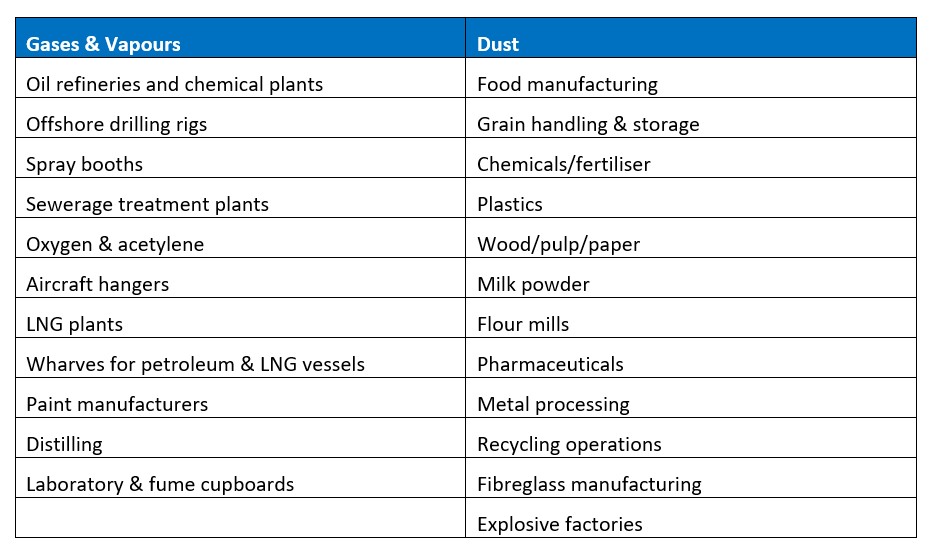The Best Guide To Roar Solutions
The Best Guide To Roar Solutions
Blog Article
The smart Trick of Roar Solutions That Nobody is Talking About
Table of ContentsThe Facts About Roar Solutions RevealedRumored Buzz on Roar SolutionsExcitement About Roar Solutions
In such an environment a fire or surge is possible when 3 basic conditions are met. This is frequently referred to as the "harmful location" or "combustion" triangular. In order to secure installations from a possible explosion an approach of analysing and categorizing a possibly hazardous location is needed. The function of this is to make certain the appropriate option and installment of devices to inevitably avoid a surge and to make sure safety of life.
(https://www.indiegogo.com/individuals/38463782)
No devices ought to be set up where the surface temperature of the devices is more than the ignition temperature level of the offered threat. Below are some typical dirt harmful and their minimal ignition temperature. Coal Dust 380C 225C Polythene 420C (melts) Methyl Cellulose 420C 320C Starch 460C 435C Flour 490C 340C Sugar 490C 460C Grain Dust 510C 300C Phenolic Resin 530C > 450C Aluminium 590C > 450C PVC 700C > 450C Soot 810C 570C The chance of the danger existing in a focus high adequate to trigger an ignition will vary from area to location.
Dangerous location electric equipment perhaps made for use in greater ambient temperature levels. Area Repair Service By Authorised Employee: Challenging testing may not be needed nevertheless particular procedures may need to be adhered to in order for the equipment to keep its 3rd party rating. Each piece of equipment with a harmful score need to be examined individually.
9 Simple Techniques For Roar Solutions
The devices register is an extensive data source of tools documents that consists of a minimum set of fields to identify each item's place, technological specifications, Ex classification, age, and ecological data. This info is essential for monitoring and managing the equipment properly within hazardous areas. On the other hand, for routine or RBI tasting examinations, the quality will be a combination of Comprehensive and Close assessments. The ratio of Comprehensive to Close assessments will be determined by the Equipment Risk, which is examined based upon ignition threat (the likelihood of a resource of ignition versus the likelihood of a flammable atmosphere )and the dangerous location category
( Area 0, 1, or 2). This variant will certainly likewise affect the resourcing demands for work prep work. As soon as Lots are defined, you can establish tasting plans based on the example dimension of each Lot, which describes the variety of arbitrary devices products to be inspected. To identify the called for example dimension, 2 aspects need to be examined: the size of the Great deal and the category of examination, which suggests the level of effort that need to be applied( minimized, normal, or raised )to the evaluation of the Whole lot. By integrating the group of examination with the Great deal dimension, you can after that develop the proper rejection standards for a sample, meaning the allowed number of faulty things located within that sample. For even more details on this process, please describe the Energy Institute Guidelines. The IEC 60079 conventional suggests that the optimum interval between assessments must not surpass 3 years. EEHA inspections will additionally be carried out outside of RBI campaigns as component of arranged maintenance and tools overhauls or repair work. These inspections can be credited towards the RBI example sizes within the influenced Great deals. EEHA evaluations are conducted to determine mistakes in electric devices. A heavy scoring system is crucial, as a solitary tool might have several faults, each with differing levels of ignition risk. If the consolidated rating of both inspections is much less than two times the fault score, the Great deal is considered acceptable. If the Lot is still considered unacceptable, it should undergo a complete examination or reason, which may set off stricter inspection protocols. Accepted Lot: The root causes of any kind of mistakes are recognized. If a typical failure mode is located, additional equipment may need inspection and repair service. Faults are identified by intensity( Security, Honesty, House cleaning ), making sure that urgent issues are analyzed and attended to immediately to reduce any type of impact on safety and security or procedures. The EEHA database must track and videotape the lifecycle of mistakes together with the rehabilitative actions taken. Carrying out a durable Risk-Based Evaluation( RBI )strategy is critical for guaranteeing conformity and safety and security in managing Electrical Devices in Hazardous Areas( EEHA) (Roar Training Solutions). Automated Mistake Rating and Lifecycle Administration: Easily take care of faults and track their lifecycle to boost examination precision. The introduction of this support for risk-based evaluation even more strengthens Inspectivity's placement as a best-in-class solution for regulatory conformity, as well as for any kind of asset-centric assessment use instance. If you want finding out a lot more, we invite you to ask for a demo and uncover exactly how our remedy can change your EEHA administration procedures.
Some Known Incorrect Statements About Roar Solutions

In terms of eruptive risk, a harmful area is a setting in which an explosive atmosphere is existing (or may be anticipated to be existing) in quantities that require special high voltage courses precautions for the construction, installment and usage of equipment. eeha training. In this short article we explore the challenges faced in the office, the danger control actions, and the required expertises to function securely
It issues of modern-day life that we make, keep or take care of a series of gases or fluids that are deemed combustible, and a range of dirts that are considered flammable. These materials can, in certain conditions, create explosive atmospheres and these can have significant and terrible repercussions. A lot of us know with the fire triangle remove any type of one of the three components and the fire can not take place, however what does this mean in the context of unsafe areas? When damaging this down right into its most basic terms it is essentially: a mix of a specific amount of release or leakage of a particular material or product, mixing with ambient oxygen, and the visibility of a resource of ignition.
In the majority of circumstances, we can do little about the levels of oxygen in the air, yet we can have significant influence on sources of ignition, for instance electric tools. Unsafe locations are documented on the dangerous area classification illustration and are recognized on-site by the triangular "EX-SPOUSE" indicator. Right here, among various other key details, zones are split into 3 kinds depending on the danger, the chance and duration that an explosive atmosphere will exist; Zone 0 or 20 is considered one of the most harmful and Area 2 or 22 is regarded the least.
Report this page